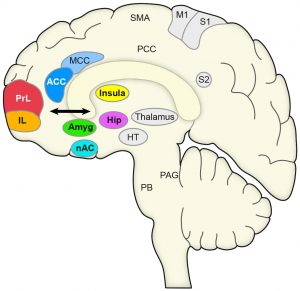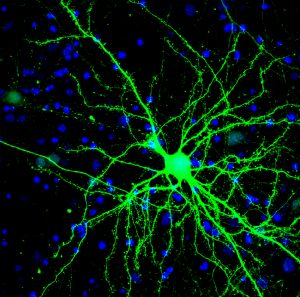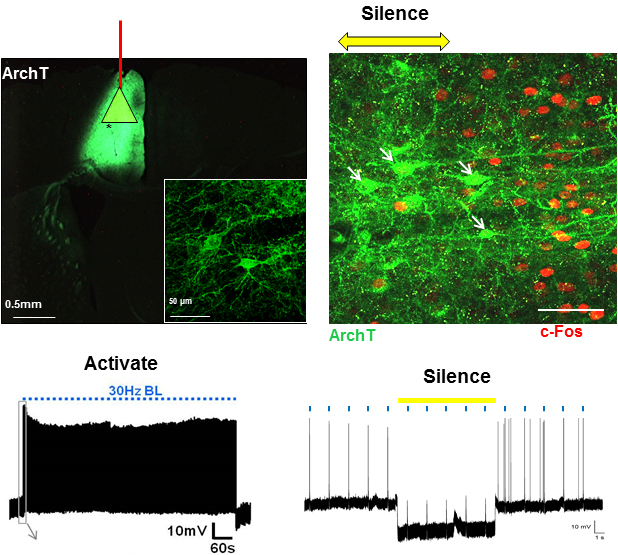Prof. Dr. Rohini Kuner
Institute of Pharmacology, Medical Faculty Heidelberg, Heidelberg University
The role of the prefrontal cortex in nociception and pain and underlying circuitry
Pain is associated with activation of complex networks comprising of various brain centres. Human imaging studies have, however, revealed a strong emphasis on pain-associated foci in the frontal cortex. Particularly the medial prefrontal cortex (mPFC) comprising of the anterior and mid-cingulate cortex (ACC/MCC), the prelimbic cortex, (PrL) and the infralimbic cortex (IL) ranks high amongst regions that are consistently activated during painful perception.
 The mPFC encodes negative as well as positive expectations and has been implicated in diverse functions, such as pain, memory, fear and decision making. The PFC, in general, has been associated with the ability to learn associations between context, locations, events, and corresponding adaptive responses, particularly emotional responses. It has, therefore, been proposed that the broad involvement of mPFC in both memory and decision making may be due to the fact that almost all such tasks involve the ability to recall the best action or emotional response to specific events.
The mPFC encodes negative as well as positive expectations and has been implicated in diverse functions, such as pain, memory, fear and decision making. The PFC, in general, has been associated with the ability to learn associations between context, locations, events, and corresponding adaptive responses, particularly emotional responses. It has, therefore, been proposed that the broad involvement of mPFC in both memory and decision making may be due to the fact that almost all such tasks involve the ability to recall the best action or emotional response to specific events.
However, the precise functional contributions of the mPFC regions to pain perception and chronicity are not known. Whereas activity and functional changes in the ACC have been well-studied in animal models ex-vivo, so far very little is known about whether and how the MCC, PrL and IL contribute to acute and chronic pain. Moreover, the extent of control exerted by the mPFC regions on the widespread activation of brain circuits in pain processing remains to be studied. Finally, it remains unclear how involvement of mPFC circuits underlies functionally-distinct processes, such as pain, decision-making, attention, positive- and negative reinforcements, amongst others. Owing to limitations on resolution, human imaging studies cannot reveal whether similar or distinct subsets of neurons participate in distinct functions of the mPFC.
perception and chronicity are not known. Whereas activity and functional changes in the ACC have been well-studied in animal models ex-vivo, so far very little is known about whether and how the MCC, PrL and IL contribute to acute and chronic pain. Moreover, the extent of control exerted by the mPFC regions on the widespread activation of brain circuits in pain processing remains to be studied. Finally, it remains unclear how involvement of mPFC circuits underlies functionally-distinct processes, such as pain, decision-making, attention, positive- and negative reinforcements, amongst others. Owing to limitations on resolution, human imaging studies cannot reveal whether similar or distinct subsets of neurons participate in distinct functions of the mPFC.
We plan to address these aspects by studying the structure-function of cortico-cortical circuits in awake, behaving mice using in vivo techniques for specifically manipulating neuronal activity and afferent function. By using tools for reversible, minimally-invasive silencing or activation of specific circuits, we study the nature of cortical circuits governing acute pain and pain chronicity in conditions of inflammatory and neuropathic pain.
manipulating neuronal activity and afferent function. By using tools for reversible, minimally-invasive silencing or activation of specific circuits, we study the nature of cortical circuits governing acute pain and pain chronicity in conditions of inflammatory and neuropathic pain.
The project offers prospective students and postdoctoral associates opportunities for training with and employing cutting-edge technologies in mouse models, including optogenetics, behavior, in vivo electrophysiological recordings and in vivo multiphoton imaging.



















